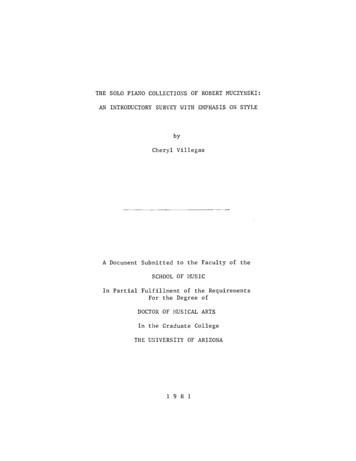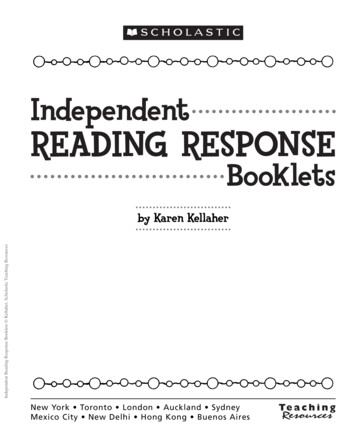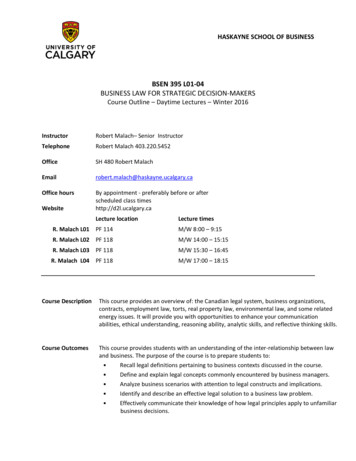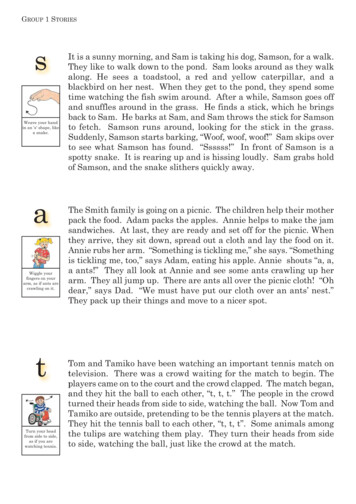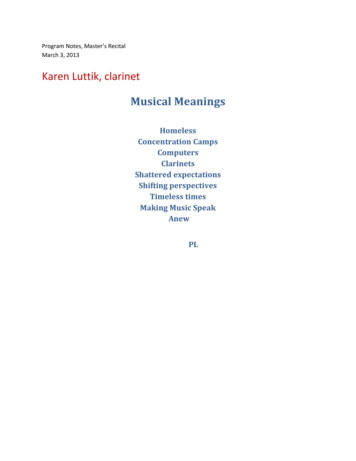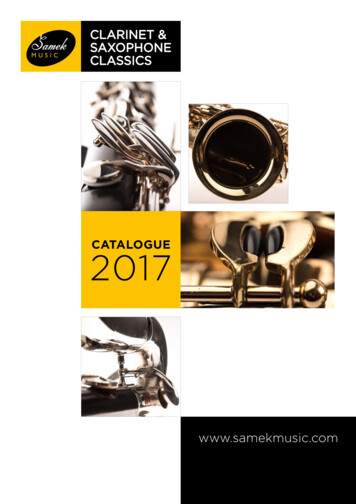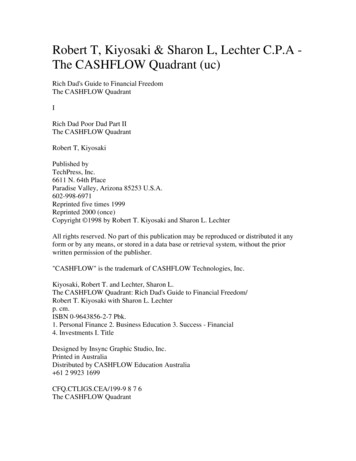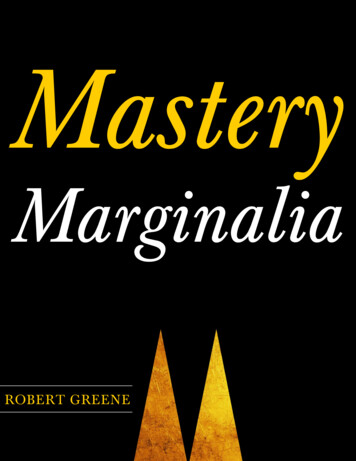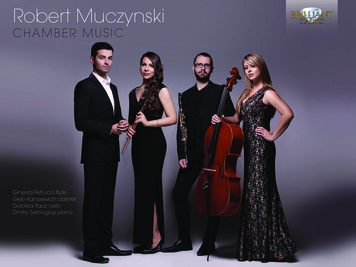
Transcription
Robert MuczynskiCHAMBER MUSICGinevra Petrucci fluteGleb Kanasevich clarinetDorotea Racz celloDmitry Samogray piano
Robert Muczynski (1929-2010)Chamber Music Fantasy Trio Op.26for Clarinet, Cello and Piano1. I. Allegro energico2. II. Andante con espressione3. III. Allegro deciso4. IV. Introduction and Finale:Andante molto e sostenuto2’533’021’533’52Sonata Op.25 for Cello and Piano5. I. Theme and Variations:Andante sostenuto8’276. II. Scherzo: Allegro grazioso 3’017. III. Andante sostenuto4’598. IV. Allegro con spirito3’06Duos Op.24 for Flute and Clarinet9. I. Andante sostenuto1’1510. II. Allegro risoluto1’0511.12.13.14.ModeratoAllegro ma non troppoAndante moltoAllegro1’440’572’041’23 Time Pieces Op.43for Clarinet and Piano15. I. Allegro risoluto16. II. Andante espressivo17. III. Allegro moderato18. IV. Introduction: Andantemolto – Allegro 5’04Sonata Op.14 for Flute and PianoI. Allegro deciso3’53II. Scherzo: Vivace1’55III. Andante4’12IV. Allegro con moto3’56Ginevra Petrucci flute · Gleb Kanasevich clarinetDorotea Racz cello · Dmitry Samogray pianoRecording: 2 October 2016, 19-20 January 2017, Dekelboum Concert Hall,College Park, Maryland, United StatesRecording production, editing, mix & mastering: Antonino d’Urzo,Opusrite Audio ProductionsCover photo and artist photos: Roy Cox Photographyp & 2017 Brilliant ClassicsRobert Muczynski was born in Chicago on March 19, 1929, to Polish and Slovakimmigrants. Displaying an early sensitivity to music, he began to study piano at theage of five. Later, Muczynski studied piano and composition at DePaul Universitywith Walter Knupfer and Alexander Tcherepnin, respectively. In 1965, Muczynskijoined the composition faculty at the University of Arizona, remaining there untilhis retirement in 1988. A list of honors and achievements includes a Pulitzer Prizenomination for the Concerto for Alto Saxophone and Orchestra, Op.41. He died inTucson on May 25, 2010, at the age of 81.Often cited as the most distinguished neoclassical composer of post-war America,several of Muczynski’s chamber works including the Sonata for Flute and Piano,Op.14 and Time Pieces for Clarinet and Piano, Op.43 have entered the activerepertoire. Muczynski embraced the neoclassical aesthetic, championed by anearlier generation of European masters like Stravinsky and Les Six, in a time whenmost young composers were being indoctrinated into serialism. In summarizingMuczynski’s musical style, musicologist Walter Simmons opined, “One mightidentify its underlying stylistic currents with reference to the phraseology of Bartók,the harmonic language and overall rhetoric found in the piano works of Barber, afondness for 5 and 7-beat meters reminiscent of Bernstein, and a piquant sprinkling of‘blue-notes’ within its melodic structures.”Composed in 1969, Fantasy Trio, Op.26 was a welcome addition to the clarinetcello-piano trio repertoire; an ensemble established by Beethoven. The first movement,marked Allegro energico, is a truncated sonata form. The first theme, introducedby the clarinet, is hurried, agitated, and unstable. It quickly yields to a steady andsomewhat melancholy second theme, with its melody confined mainly to the cello.A repeat of the exposition is followed by a brief yet remarkably comprehensivedevelopment that ends the movement without a recapitulation to provide a sense ofclosure. The Andante opens with a sorrowful theme in the cello, escorted from belowby a gloomy, droning motive in the piano. Following a metric modulation, the pianoperpetuates the dark mood established in the beginning with a new theme, murky
and mysterious, all the way to the end. The third movement, marked Allegro deciso,brings back the agitated character of the first, with all three instruments exchangingthematic ideas throughout. The final movement, titled Introduction and Finale,presents something quite different. The Andante theme of the Introduction evokesBarber and Bernstein while the Allegro theme of the Finale is a reimagined accountof the Flintstones theme by Hoyt Curtin, altogether a stark contrast to the characterof the first three movements. Regarding the entire trio, Muczynski said, “The workalternates between rather terse rhythmic statements and sustained lyrical momentsclimaxing with a movement full of exuberance and unabashed joy. I enjoyed writingthis music, and I’d like to think that some essence of that experience is conveyed tothe listener.”Sonata for Cello and Piano, Op.25 of 1968 is often considered to be Muczynski’schamber music masterpiece. The first movement is a theme and variations: a ratheruncommon choice of form for a cello sonata. The theme itself, played in full by solocello, is based on the blues scale. Across nine variations, including a solo postludefor each instrument, Muczynski expertly tackles problems of balance commonlyencountered in the genre through clever use of register, rhythmic play, and melodicexchange. The Scherzo brings energy, sharp dynamic contrasts, and frequent metricmodulations all within a rhythmic framework of a dance. The slow movement,marked Andante sostenuto, consists of several themes all sharing a character ofmelancholy and longing. Here, the cello truly comes into its own, leading everyepisode with meditative, lingering melodies. The final movement, marked Allegro conspirito, is a rondo full of jubilant vigor and spirit, as implied. Nearing the coda, thetheme from the first movement returns for one final appearance, giving the sonata asense of having a single, overarching narrative. The rondo ends in a fashion typicalof Muczynski, with boosted tempo, snappy rhythmic accents, and technical fireworksfor both instruments.Originally composed for two flutes in 1973, Duos for Flute and Clarinet, Op.24were arranged by the composer in 1984 for clarinetist Mitchell Lurie and flutistJulius Baker. Although rather minimal in scope, these duos nonetheless capture all ofMuczynski’s signature stylistic features, including transparent textures, asymmetricmeters, and blues-derived melodies.Muczynski’s most popular work in any genre is undoubtedly his Time Piecesfor Clarinet and Piano, Op.43. Completed in 1983, the suite is both a perfectinstructional tool and an indispensable recital component due to its superb utilizationof both instruments, showcasing their sonic, technical, and dramatic capabilities.The opening Allegro risoluto is dominated by a brisk, angular theme in the clarinet,pillared by a piano part that acts both as an extension and a counterpoint. Thefollowing Andante espressivo, often overcast and somber in mood, includes one ofthe work’s three cadenzas for the clarinet which display the instrument’s technical andsurprisingly, polyphonic potential. The third movement, marked Allegro moderato,lightens the mood with a character of unburdened youth and the pace of an unhurriedstroll. The finale, bookended by a pair of clarinet cadenzas, is an animated dancewith gigue-like flair and syncopated rhythms, flowing seamlessly from one metricmodulation to another. Muczynski described the piece thus, “Technically andmusically there is quite a lot going on in this four-movement suite, and much of thetime both instruments share the action equally. The music is made up of a number ofelements: energetic, syncopated rhythms, long and sustained melodic lines, cadenzasfor solo clarinet, tongue-in-cheek humor and an overall ‘up’ feeling. For me the titlerefers to when and where I was composing the work, sort of a frozen-in-time idea.”Completed in 1961, Muczynski’s Sonata for Flute and Piano, Op.14 stands asthe most important contribution to flute repertoire by an American composer. Thework received a top prize at the Concours International in Nice, France. Muczynskidescribes the work with the following notes, “In Sonata-allegro form, the firstmovement begins with a syncopated four-note figure announced by the flute. Ithas a restless urgency about it. This motive is gradually expanded, developed,and varied as the music unfolds. There is frequent reference to it as both flute andpiano share the ongoing dialogue. A pulsating energy is maintained throughout.
The chattering Scherzo is both whimsical and headstrong, requiring considerablecontrol and endurance from the flautist. It is concentrated music; it goes by quicklyand establishes a need for the contrasting movement that follows. As a respite fromthe two energetic movements, the Andante favors a kind of intimate and sustainedmusic wherein the flute is assigned expressive, soaring lines of high intensity while thepiano provides a subdued accompaniment throughout. The final, fourth movement,in rondo form, resumes the impetuous character of the opening music and sweepsalong until arriving at a reckless cadenza for the flute, followed by an outburst fromthe piano, as both instruments share in a conclusion of staggered rhythms and all-outabandon.” Dmitry SamograyGinevra Petrucci flutePraised by the Italian press as being “one of the mostinteresting talents of her generation”, and describedas having “a beautiful phrasing, brilliant virtuosityand a legato worthy of a great singer” by The FlutistQuarterly, Ginevra Petrucci has performed in someof the most prestigious concert halls throughoutEurope (Sala Accademica di Santa Cecilia, Rome;Teatro La Fenice, Venice; Salle Cortot, Paris; LisztAcademy, Budapest; Chopin Academy, Warsaw),America (Carnegie Hall, New York; Kennedy Center,Washington D.C.), Japan (Ohji Hall, Tokyo), SouthAmerica and Middle East. She performs regularlywith artists such as Bruno Canino, Rocco Filippini,Boris Berman, David Radzynski, Emmanuel Ceysson,Jory Vinikour. Her recordings include Briccialdi’sfour flute Concerti with I Virtuosi Italiani, Kuhlau’squintets with the Kodály Quartet, a recital CD withBruno Canino, Dupuy and Büchner’s Concerti withI Pomeriggi Musicali and the first album entirelydedicated to the flauto d’amore. She is visitingprofessor at international institutions and she has worked with composers KaijaSaariaho, Steve Reich, George Crumb, Betsy Jolas and Jean-Michel Damase and shecollaborates with Nuova Consonanza Contemporary Music Festival and La Biennaledi Venezia. Born in Rome in 1989, she studied at Conservatorio ‘Santa Cecilia’ ofRome with her father, to continue her education at École Normale ‘Alfred Cortot’(Paris) with Pierre-Yves Artaud and at the Yale University (USA) with RansomWilson. She is the President of the Leonardo De Lorenzo Association.
Gleb Kanasevich clarinetDescribed as “stellar” (New York Times), and“brilliant and indefinable” (The Art Mag,Charleston), Gleb Kanasevich has garneredacclaim as a clarinetist, composer, chambermusician, and contemporary music specialist.He has appeared as a soloist with orchestrassuch as the Baltimore Symphony Orchestra andBelarus National Philharmonic. Kanasevich’scompositions have been performed by EnsembleIntercontemporain, Orchestra Philarmonique deRadio France, Spoleto Festival Orchestra, CantataProfana, and Miranda Cuckson. As a residentartist, Kanasevich has been featured on stagesof Spoleto Festival USA, soundSCAPE Festivalfor Contemporary Music, 50th SCI NationalConference, MusicArte Panama, and has beeninvited as a visiting composer and performer atvarious institutions of higher learning, includingUniversity of Oxford, Frost School at University ofMiami, Brandeis University, Princeton University, amongst others.Kanasevich plays with Ensemble Cantata Profana, winner of the 2016 ASCAPAdventurous Contemporary Music Programming Award. He has closely collaboratedwith composers such as David Lang, Michael Nyman, Helmut Lachenmann, andRichard Barrett, to name a few. Kanasevich received his Master’s degree in clarinetunder David Shifrin from Yale University, and his Bachelor’s degree in clarinet fromthe Peabody Institute of the Johns Hopkins University, where he studied underAnthony McGill.Dorotea Racz celloCroatian cellist, Dorotea Racz, has performedextensively throughout Europe, Asia, as wellas North and South Americas, in venuessuch as Carnegie Hall, Kennedy Center, andMozarteum in Salzburg. Festival appearancesinclude Washington’s European Month ofCulture, International Festival “UmbriaClassica”, Festival Rovinj, and PagArt Festival.An ardent chamber musician, Racz is afounding member of Racz-Samogray Duo andEnsemble Accendo. Her solo and chambermusic performances have been broadcasted onHRT Radio and Television. Racz has collectedover thirty top prizes at competitions suchas the International Competition “CasarzaLigure”, International Competition “AntionioJanigro” for young cellists, and InternationalCompetition “Valsesia Musica,” to mention afew. Recent highlights include a tour of SouthAmerica, with recitals in Buenos Aires, Santiago, and Lima.Racz was awarded a full merit scholarship at the age of sixteen to study with AmitPeled at the Peabody Institute of the Johns Hopkins University, where she completedher Bachelor’s and Master’s degrees in music. She completed her Doctorate in musicat the Catholic University of America, in the studio of Michael Mermagen. Based inWashington, Racz is the co-director of Audeamus International Music Festival, in herhometown, Zagreb.
Dmitry Samogray pianoInternationally active as performer, recordingartist, pedagogue, and artistic director,American pianist Dmitry Samogray is rapidlyestablishing himself as a noted figure amongstthe new generation of classical music artists.Samogray concertizes regularly throughoutEurope, as well as North and South America.Festival appearances include Washington’sEuropean Month of Culture, Festival Rovinj,and Leonardo De Lorenzo Festival.A passionate collaborator and advocateof 20th and 21st century chamber music,Samogray is the founder and co-director ofAudeamus International Music Festival inZagreb, Croatia. Launched in 2015, Audeamushas been received with enthusiasm by the publicand press, the latter calling it a “distinctivemusical
Sonata Op.25 for Cello and Piano 5. I. Theme and Variations: Andante sostenuto 8’27 6. II. Scherzo: Allegro grazioso Muczynski’s musical style, musicologist Walter Simmons opined, “One might 3’01 7. III. Andante sostenuto 4’59 8. IV. Allegro con spirito 3’06 Duos Op.24 for Flute and Clarinet 9. I. Andante sostenuto Composed in 1969 .
